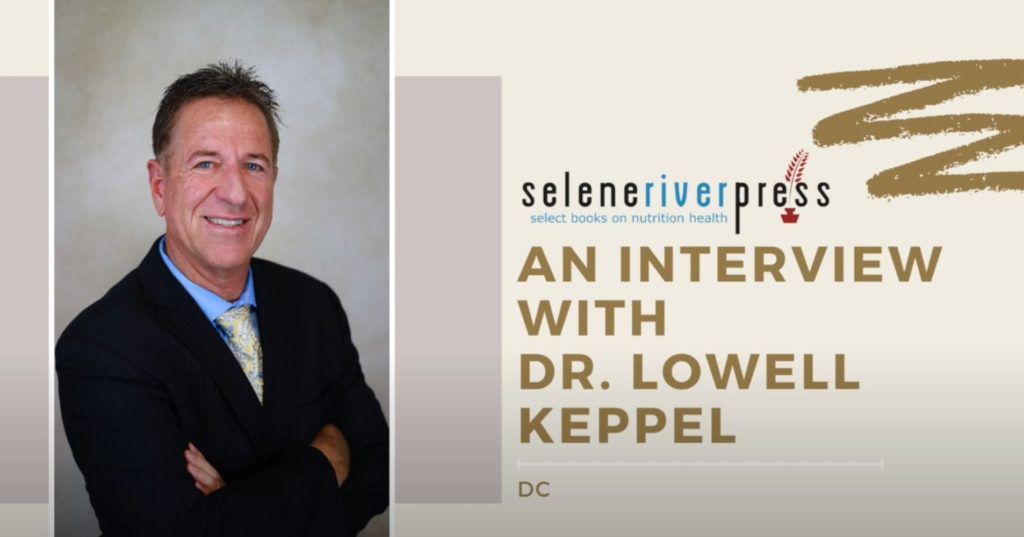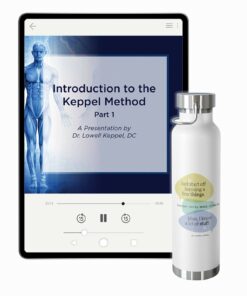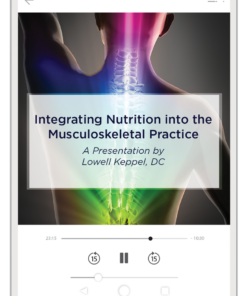Welcome to the latest installment of our Selene River Press Practitioner Interviews series. Dr. Lowell Keppel sits down with SRP managing editor Danielle LeBaron to talk about the people who shaped his career, the wisdom he’s learned along the way, and the advice he shares with practitioners who seek his counsel. As he explains to Danielle, it all comes down to the importance of simplicity.
To listen to the interview in full, click here.
Danielle LeBaron: Hello and welcome to Selene River Press Practitioner videos, a series of interviews with some of our most prominent writers and authors. Today I have the pleasure of speaking with Dr. Lowell Keppel. Thank you so much for being with us today.
Dr. Lowell Keppel: How are you doing? It’s lot of fun to be here.
Danielle: We’re so glad to have you. So for today, I’d like to talk to you about your story—who you are, your practice, and specifically how you got into chiropractic care and Muscle Response Analysis.
Dr. Keppel: Sure. I have a practice in Westminster, Colorado. I’ve been doing that for about the last 36 years. I got into chiropractic because of my brother-in-law. He’s passed away now, but he graduated from chiropractic college while I was in high school. I knew I didn’t want to do construction, and I thought, you know, being a chiropractor sounds like a pretty good deal. So I made my decision to be a chiropractor when I was a junior in high school. And I set all my goals towards that. I graduated high school and went and got my pre-chiropractic requirements out of the way. I went to chiropractic college and ended up graduating at the ripe old age of 24. You asked about Muscle Response Analysis, the muscle testing technique that I teach and share with folks. I got into muscle testing while I was in chiropractic college, and it was a natural fit. I went to Logan, and at that school they were pretty open. We got to learn muscle testing, and I started using it to find the subluxations that needed to be adjusted on people. When I got out of school, it was my primary way of finding out, what do I need to adjust on these guys?
And then in 1988 or ‘89, I went to a seminar here in Denver that Mark Anderson put on, called Contact Reflex Analysis. It was done by Dr. Dick Versendaal. There’s a little history with me and Dr. Versendaal because my mom was actually a patient of his.
Danielle: Oh, wow.
Dr. Keppel: Yeah! When I graduated chiropractic college, he told my mom, “Send your boy up, let him hang out with me for a little bit.” So I did, and I gotta be honest. I left his office with no idea what this guy was doing. It seemed like it was kind of complicated and over my head. But that was in 1984. By 1989, I had a few years of experience under my belt. I went to the seminar. And the whole time, my wife was poking me going. “You gotta, you gotta learn this!” And I go, “I know, I know.” And I did. That’s how I started implementing Standard Process products into my practice, through the contact reflex analysis. So many other muscle-testing techniques were born out of contact reflex analysis.
That led me into the early ’90s. I got into Neuro-Emotional Technique, taught by Dr. Scott Walker, and that was very influential for me. Most of MRA actually correlates with Neuro-Emotional Technique and the reflexes that it uses. It also has some of the contact reflex analysis, and some of the stuff that Dr. Versendaal was teaching. MRA is kind of a combination of these different techniques that I’ve learned over the years. I also learned another one called total body modification.
Danielle: That’s a really amazing story, from the 1980s all the way to now. Talking a little bit about Muscle Response Analysis…you’ve come a long way since then. You’ve published quite a few products on Muscle Response Analysis with Selene River Press. Can you tell us a little bit about those in particular—why you created them, what they are, and who they’re for?
Dr. Keppel: Well, the reason we create these things is to help the practitioner in his office. Because when you’re in front of a patient, sometimes you forget, sometimes you freeze, or sometimes you just don’t think of something. If we can have something like the MRA chart—which I think is absolutely beautiful. Tracy Hoffman was involved with putting that together, and the people at Selene River Press with editing it and adding the colors. But it’s nice to have it on your wall so you can look at it and go okay, what am I missing? What am I forgetting? I have my MRI chart on my wall, and not a day goes by that I don’t look at it. And we have the MRA Quick Points Guide. The person who used to work with Melissa Taylor, her name was Roxanne, was very instrumental in putting that together. There’s so much information there. To have that quick reference guide is a must for everybody.
We put these products together and price them in a way so that doctors will be able to use them. The nice thing about MRA that I keep hearing, even from people who’ve been muscle testing a long time, is that it’s simple, repeatable, and consistent. And you can take care of probably 80 or 90 percent of what walks into your office, just if you follow the MRA procedures. With the muscle testing and the encouragement of Mark Anderson, we put together the Keppel Method, as Mark calls it. It’s a combination of muscle testing with observational findings and another procedure that’s been taught a long time called the Nutritional Exam. So you have these different ways of being able to check the patient. If you’re not a muscle tester, you can still learn a lot of ways to figure out what supplements a patient might need by using the Keppel Method, looking at observational signs. Like for instance, the outer third of the eyebrows disappearing—that can be a sign of the thyroid. You’re looking at your patient, and you’re like, “Whoa, I see this going on. Let me check this now.”
That’s the great thing about the Keppel Method. These e-learning videos are live seminars, which is nice, because you get the interaction with the audience and different questions, that kind of stuff. Muscle testing is always evolving. As I learn more about Dr. Lee and his formulations, and how he used them, it expanded how we can use his formulations and muscle testing in areas that we maybe wouldn’t think about. Like gallbladder problems. One of the things that doesn’t get used very often is disodium phosphate. Now it (muscle testing) is expanding the practitioner’s awareness of products that will zero in and help the patient the most. It really takes the guesswork out of putting together a protocol.
Danielle: Great. I love that you talk about how we have so many different MRA products—posters, charts, and your e-learning for those who don’t know about Muscle Response Analysis. That’s great. Let’s talk a little bit about more about your MRA products specifically. Who for you is the best audience for them, and how can other practitioners who are interested incorporate these products into their practice?
Dr. Keppel: Well, any Standard Process practitioner would benefit from this information. It doesn’t matter if they’re a chiropractor. It doesn’t matter if they’re a physical therapist, acupuncturist, nutritionist, whatever—they’re going to benefit from these products. Anybody with a Standard Process account would do well with them. How they incorporate them in their practice to me is kind of easy. But then again, it’s been second nature for me for the last 30-some years. One of the things that I try to share in the videos is how easy it is to take one or several of these tools and apply them to your patients. It’s really up to the practitioner. I’ve run across doctors, and even good friends of mine, who never could get the hang of the muscle test. Just couldn’t do it. Okay, fine. So use leg-length checking. It’s a great tool, and I show that in the videos. How do you incorporate it in your office? Well, you just have to jump in and do it. You have to make the commitment that, hey, today I’m going to check my patients for just one Standard Process product. Let’s just say Zypan, for instance. And I’m going to use the leg-length method. So every patient that comes in today, I’m going to leg-length check them to see if they need Zypan, regardless of what they tell me. You’d be very surprised at how many people are going to show that they need it, and how simple it is. One of the big things for chiropractors is, “How much time is this going to take me?” But it doesn’t take any time. I mean it’s an extra 20 or 30 seconds—at the most. You can start off very simple, and naturally what’s going to happen is that it’s going to grow.
I was talking to a friend of mine, a chiropractor, and I said, “Hey, you know we’re thinking about putting together some new products, primarily for the chiropractor. If you had something like this, where you have a spinal subluxation—let’s just say T9 keeps subluxating on this patient. If you have a reference where you could see T9 relates to the adrenal glands, and you wonder if Drenamin is going to help this patient? Would that be something that you would like?”
He goes, “Oh, yeah, I would love that. Because it’s so clean. It’s so simple. And to be honest with you, I don’t want to know all the in-and-outs about the adrenal glands. I just want to know the basics, and what’s going to help.”
Fair enough, right? Then you’re going to have other practitioners who will evolve, like I did, where I started using this stuff for subluxation. Then I started learning more about the adrenals. I started learning more signs and symptoms of adrenal insufficiency to help me get there quicker. I started learning more about the thyroid and the interaction of the thyroid with the adrenals. And I started going deeper because quite honestly, it really interested me.
Danielle: I love that you’ve talked a few times about the simplicity of these products. I think that’s a key thing that so many people look for. Even if later they delve deeper, they want that simplicity to really understand something first. That’s a good point. Now my next question may be a bit harder. I’d like to know how you address those doubts about muscle testing, for those who think that it’s not a reliable method? I’m sure this is something you’ve heard?
Dr. Keppel: Oh, yeah—only my entire career! Absolutely. You know, over the years people have called me the witch doctor, or the voodoo guy, or whatever. They didn’t really mean anything by it, because they realized that it worked, and that it was helping them. It was kind of a term of endearment. How do you address that? Well, oddly enough, this is the conclusion I’ve come to the last couple of years—again, thanks to Mark Anderson of Standard Process West. Everything we do, we can back up with research. Muscle testing, we can backup with research. I’ll even look at the skeptic, and I go, if you want research, I will bury you in research. That’s how much stuff is out there. The problem is, most people, most practitioners, don’t know where to find it. If you want some good research on muscle testing, I recommend people go to a website called the One Foundation (OneFoundation.org).
Danielle: Okay.
Dr. Keppel: And you can see some of the research there. Now, you might not be able to see all of it because you may need to a membership for the One Foundation. This is a nonprofit organization that’s been doing a lot of research on muscle testing and a lot of research on Neuro-Emotional Technique. A research article just came out on low back pain and Neuro-Emotional Technique. And how they set up the research is quite phenomenal. They were using inflammatory markers of the blood. They found that the group that was getting the NET procedure actually change their inflammatory markers in their bloodstream. Of course, anytime you do research, you need to get rid of all the extra variables, right?
Danielle: Of course.
Dr. Keppel: But we can take that same information and use it as far as substantiating muscle testing, and that it does work. But we also know that if we took patients and not only added the NET but also added in the Standard Process products, we would get even better results. Maybe someday that kind of research will come down the pike. But the One Foundation is a great resource for getting research to validate muscle testing.
The other thing I do is give every new patient that comes into my office a paper I wrote called the Amazing Muscle Test. I make this available at no cost to any practitioner that comes to my seminars or my webinars. I just hand it to them and say, this is the history of muscle testing. This is what muscle testing is about. This is what it’s not about. Muscle testing isn’t going to tell you winning lotto numbers. Because if it was, we wouldn’t be sitting here talking!
Danielle: Yeah—because then you’d be a really good witch doctor, and we’d all be coming to you!
Dr. Keppel: Yes. Plus I think that now people are more open to it. I get very little pushback or skepticism. Usually patients are laughing, and I’m like, “Why are you laughing?” And they say, “I just can’t believe this. It’s amazing, I just can’t believe it.” So that’s what I deal with now.
Danielle: That’s great. It’s an awesome way of addressing it—with the research, and then just showing your patients it works. I want to switch tracks and talk more about you and your history. Particularly, who have been major influencers or role models for you, especially with Muscle Response Analysis? Who helped you get into it and helped with some of the concerns you had?
Dr. Keppel: Sure. Like I said, I started learning muscle testing in school. I’d say that some of my classmates probably helped me go into that direction. But I knew I was going to head that way anyway because of my familiarity with chiropractic and my brother-in-law. But over the years, I would have to say that George Goodheart has been at the top of the list when it comes to muscle testing. He’s the father of muscle testing. And he developed applied kinesiology, which is to me the governing body of muscle testing, if you will. It was George Goodheart who really put together so many pieces of the puzzle. Even though I never officially met the man, I did get to go to a seminar he did for Back to School for Doctors—one of the last seminars he ever did. So there’s that.
And then, of course, I mentioned Dr. Dick Versendaal with the CRA. As far as strictly muscle testing, the guy who is probably at the top of the heap right now is my mentor, Dr. Scott Walker, who developed the NET stuff. I actually consult with Dr. Walker quite a bit. A couple of years ago, I was like, “Hey, Dr. Scott. You know, I’m getting skeptical of my muscle testing. I’m really kind of concerned about it.” He goes, “I’d worry about you if you weren’t skeptical about it.”
So it’s about always kind of checking in with yourself. Because the thing about muscle testing is that the practitioner really has to be unbiased. They have to get themselves in a place of total neutrality, of just checking the patient and looking for the response and not putting their educated mind too much into it. Because muscle testing can be subjective. I would say that those were probably my biggest mentors when it comes to muscle testing. And didn’t you ask about other mentors as well?
Danielle: Yes. Just people who specifically influenced you, especially when you’ve had concerns. But it sounds like you’ve had these great people to help you when you say, I’m not so sure about this.
Dr. Keppel: Exactly. I think along the same lines. With help developing MRA, there’s got to be Mark Anderson. Without him giving me the opportunity to share this with other practitioners, it wouldn’t be anywhere. And I also really appreciate Mark Anderson for instilling in me this great appreciation for the founder of Standard Process, Dr. Royal Lee. And really grabbing hold of the Lee philosophy, and having a desire to delve deeper into the formulations, to understand how and why they work. And more importantly, how and when to apply them. There’s also Joseph Antell, who has been working with Standard Process a long time. I mean, he was really the one who scoped me out, went back to Mark and said, “Hey, I think we ought to give this guy a shot.” So Joseph was very instrumental in that.
Danielle: Oh, wow.
Dr. Keppel: But, of course, Dr. Lee. Where would we all be if he wouldn’t have done what he did?
Danielle: Absolutely. Those are some incredible role models who helped influenced your life. And I want to talk about other practitioners. Surely, there must be lot of people out there who are at the same place you were many years ago, trying to figure all of this out. What would be your main piece of advice for them, especially if they’re new to Muscle Response Analysis?
Dr. Keppel: Well, going back to my mentor, Dr. Scott, he says, “I like simple. Simple works.”
Danielle: That’s great.
Dr. Keppel: That’s one reason why I’ve tried to keep MRA simple. If you’re out there and you’re wanting to learn muscle testing—and I personally believe that everybody can learn muscle testing. I mean, if I can do it, anybody can do it. But it just takes a little bit of practice. Maybe for some people it takes them changing their noggin up here, from going, “I can’t” to “Hey, maybe I can do this.” But as you start learning it, keep it simple. Don’t make it too complicated. It’ll grow after a while.
The other thing with practitioners today—I’m gonna sound like the guy who had to walk to school uphill both ways in the snow every day. But back when I was first learning in the late 1980s and early ’90s, we didn’t have all the Zoom meetings. We didn’t have all the technology like we have today. We had cassette tapes. We had videotapes. And we paid a hefty price for those rascals as well! But take advantage of the tools that are out there. Standard Process West offers Wednesday webinars, absolutely free. Mark Anderson charges a nominal fee for our in-person seminars. Show up to them. The other thing is our mentor program—contact your mentor and pick their brains. One of the things that I’ve found is that practitioners who decide they’re going to do that— and they contact me on a regular basis—they see a nice, steady increase in their accounts with Standard Process. But they’re also seeing phenomenal results with their patients. They’re seeing patients getting better, faster. Of course, it’s the natural evolution—now these people are asking me about non-chiropractic issues. And it’s just so wonderful. So for the practitioner out there that’s fairly new: Use your mentor. Get on the educational availabilities. The products we have are inexpensive. Not just mine, but all of the audios that Mark Anderson has made, and that Dr. Michael Gaeta has made. There’s no shortage of great information to get you going. The one thing I caution is, don’t be overwhelmed. Keep it simple. Just start off with a few things. One day you’ll wake up and go, “Man, I know a lot of stuff.”
Danielle: That’s great advice. I love that we keep bringing it back to “keep it simple.” Just get into it. Build from there. That’s great advice for anybody, and for Muscle Response Analysis or any type of chiropractic care. This has been great. I’ve learned so much. I’m excited for all our listeners to hear this. Before we end, is there anything else you’d like to say?
Dr. Keppel: Just don’t get overwhelmed. One of the things I run across with new practitioners is, well, I’m afraid to do this, because I don’t know enough. Okay, well look. When I started, I didn’t know jack squat. All I knew was from Dr. Versendaal: this reflex, this supplement. That’s all I knew. And that’s what I went with. I would say, You do know enough. That’s where you have all your support people behind the curtains, your mentors, to help you out. Don’t get overwhelmed thinking you’ve got to learn about all 200 products or whatever we have in Standard Process and the other hundred products or so we have in Medi-Herb. Don’t worry about learning all those because there’s a chance you may have some products that you’re never going to use, and that’s okay. But it’s nice to know that they’re there. You’re going to see what the focus of your practice is really about. For me, being the chiropractor, it was about helping people fix their subluxations. And there’s a foundation for that, and a simple method of adding on to that. That’s where a product we have, “Integrating Nutrition into the Musculoskeletal Practice,” can come in so handy. So keep it simple. Don’t be overwhelmed.
Danielle: Well, this is all incredible advice. Thank you so much for taking the time to be with us, and for all the wisdom that you shared with us.
Dr. Keppel: My pleasure. Anytime. Thank you.





